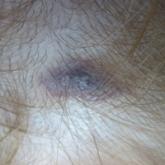Case Letter
Oral Fixed Drug Eruption Due to Tinidazole
To the Editor:A 50-year-old man presented with a painful ulcer and a burning sensation on the tongue of 2 days’ duration (Figure, A). The ulcer...
Ms. Engelhart is from Harvard Medical School, Boston, Massachusetts. Dr. Segal is from the Division of Dermatology, University of Arizona, Tucson.
The authors report no conflict of interest.
Correspondence: Robert J. Segal, MD, Division of Dermatology, University of Arizona, 3838 N Campbell Ave, Tucson, AZ 85719 (rsegal@deptofmed.arizona.edu).

Allergy as a cause of adverse outcomes in patients with implanted orthopedic hardware is controversial. Allergy to titanium-based implants has not been well researched, as titanium is traditionally thought to be inert. We highlight the case of a patient who developed systemic dermatitis and implant failure after surgical placement of a titanium alloy (Ti6Al4V) plate in the left foot. The hardware was removed and the eruption cleared in the following weeks. The plate and screws were submitted for metal analysis. The elemental composition of both the plate and screws included 3 major elements—titanium, aluminum, and vanadium—as well as trace elements. Metal analysis revealed that the plate and screws had different microstructures, and electrochemical studies demonstrated that galvanic corrosion could have occurred between the plate and screws due to their different microstructures, contributing to the release of vanadium in vivo. The patient was patch tested with several metals including components of the implant and had a positive patch test reaction only to vanadium trichloride. These findings support a diagnosis of vanadium allergy and suggests that clinicians should consider including vanadium when patch testing patients with a suspected allergic reaction to vanadium-containing implants.
Practice Points
Metal allergy in patients with orthopedic implants can cause serious problems including dermatitis and implant failure.1 As life expectancy increases, the general population ages, and more metallic orthopedic implants are placed,2 allergy to these implants is expected to be a problem of greater significance. Uncertainty remains regarding best practice for patients with suspected metal implant allergy.1 The major questions are: Who should be tested? When should they be tested? What are the optimal tests to diagnose metal allergy?3-8
We report the case of a patient with vanadium allergy who developed a diffuse eczematous dermatitis and implant failure after receiving a vanadium-containing titanium alloy orthopedic implant in the left foot. This case is remarkable because hypersensitivity reactions to titanium-based hardware are rare, as they traditionally have not been thought to provoke allergic reactions.9
A 62-year-old woman who was otherwise healthy presented with an eruption of more than 80 pruritic, nummular, eczematous plaques on the arms, legs, back, and buttocks of 3 weeks’ duration (Figure 1). She had a history of allergy to metal used in costume jewelry. Six weeks prior, the patient underwent implantation of a titanium alloy plate in the left foot for surgical repair of painful deforming osteoarthritis. A radiograph of the foot showed appropriate placement. According to the manufacturer, the plate was composed of the compound Ti6Al4V, which contained 90% titanium, 6% aluminum, and 4% vanadium. The lesions developed on the skin close to but not directly over the surgical site.
A punch biopsy of one of the lesions on the shoulder showed lymphoeosinophilic spongiosis consistent with a delayed hypersensitivity reaction (Figure 2). There was mild clinical improvement of the eruption with topical steroids. A course of prednisone for systemic effect resulted in clearing of the eruption, but it promptly recurred on cessation of the steroids. The patient was then patch tested using the North American 80 Comprehensive Series, with an additional 59 common textile, shampoo, fragrance, and several metal allergens, all of which were negative.
To the Editor:A 50-year-old man presented with a painful ulcer and a burning sensation on the tongue of 2 days’ duration (Figure, A). The ulcer...

The reported sensitivity and specificity of enzyme-linked immunosorbent assay (ELISA) for bullous pemphigoid (BP) diagnosis is approximately 87%...

A 32-year-old woman presented with a recurrent painful eruption on the scalp of 1 year's duration. The lesion occurred on the left temporal region...
